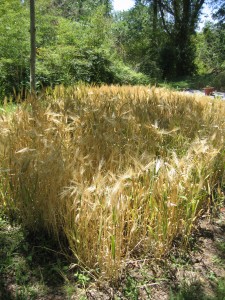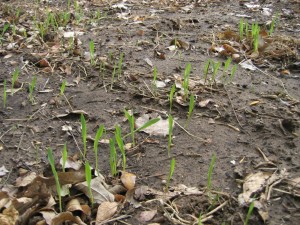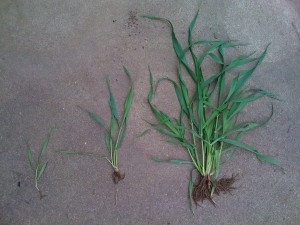
Me, with my “scythe” (a big butcher knife), harvesting barley in April 2009. (Where I live, it gets planted in November, and harvested the next Spring.)
If you live in the northern half of the United States or the southern part of Canada — or in the corresponding latitudes elsewhere in either hemisphere — it’s time to think about planting barley. In these cooler regions, barley is planted in the spring. It is typically harvested between 100 and 130 days later. In warmer regions, it is planted in the fall as a winter barley.
Brewers can plant barley for decoration, or they can harvest it and use the resulting grain in their beer. You can use unmalted barley as an adjunct, especially for farmhouse-style ales, or you can try your hand at malting the barley.
Barley Seed
Finding barley seed sold in amounts suitable for a garden can be difficult. One garden seed company, Johnny’s Select Seeds, sells both Robust 6-row barley and Conlon 2-row barley. These are both malting varieties that are widely grown in North America. They also carry oats and red spring wheat. You may also want to check with your local agricultural extension. And if you’re more interested in home malting than growing, you can use this seed for malting. (We’re not connected to Johnny’s Seeds in any way.)
When to Plant
Barley can be sown as soon as the ground is workable. In fact, given the time it takes to mature, it’s best to get it in the ground as soon as possible. Germination can occur at temperatures as low as 34 °F (1 °C).
Barley can be planted in average soil. In fact, for malting barley varieties you do not want to over fertilize it. The amount of seed sown per acre varies with the variety. For a small garden plot, a pound of seed for every 500 sq. ft. will put you in the correct ballpark. It’s best to plant barley in a location that gets full sun.
Sowing and Growing
To sow the seed, first rototill your barley patch, then rake it with a thick-tined rake, leaving a series of little furrows. Broadcast the seed, either with a spreader or by hand. Then, rake at a 90° angle to the furrows to push the dirt over the seed. Don’t worry if some of the seed is still visible. Water the garden, if the soil is not already wet, so that the seeds will quickly absorb the moisture they require to sprout. Once you’ve sowed the seed, there is little else to do but sit back and literally watch the grass grow. Growing barley is not as difficult as growing most garden vegetables. There’s no trellising, pruning, or any other interventions needed in the growing season. Barley is fairly drought-resistant, so you don’t usually need to worry much about watering it if you are getting a reasonable amount of rain. If you experience an extended period without rain, set up your sprinkler and give the barley a drink.
For malting purposes, you do not want the barley contain a lot of nitrogen. As such, do not add any nitrogen-containing fertilizer once the barley reached the 3-leaf stage.
Growth Series
Barley emerges from the soil as a coleoptile (a small sheath), and soon a single leaf emerges from the coleoptile. The central stem gradually adds leaves until it reaches the five leaf stage. At this point, tillering starts. During this stage, secondary stems arise on the planet. The next stage is called elongation. This is when the stems “telescope” and the plant quickly grows taller. Eventually, the “head” emerges near the top of the plant. The seeds first fill with water, then with “milk.” The “milk” is water with starch mixed in. As more starch is deposited in the seeds, the interior turns to “soft dough,” then into “hard dough.” Then, the plants die and lose their green coloring. The farmer lets the grain dry in the field prior to harvest. As such, there is no need to water the barley after it has reached the “hard dough “stage. (More on the growth of barley can be found here.)
What Comes Next?
Growing barley is extremely easy. It’s what comes next that gets complicated. You need to find a way to separate the barley seed from the other plant material. The traditional way of doing this would be to throw the grain in the air on a windy day and let the wind blow away the chaff. Repeat until the seed is relatively clean. Then, you can proceed to use it as an adjunct in your brewing, or you can attempt to malt it. In later articles, I’ll explain how to use raw barley in brewing beer and how to malt barley.

Amber waves of grain — barley drying out in my garden. Let the barley turn completely brown and harvest when it’s completely dry.
—
Related articles




Great article. I would love to grow my own barley. I can make great beers now. But I want to learn the process of growing my own materials.
I am thinking about trying to grow ingredients for home brewed beer. I found article hopeful Now I will investigate hops!
Great article. I was just looking at doing it for food (: (I have a big yard, and grass feels like a waste of space)